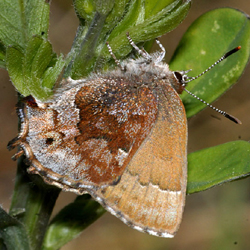Find a Butterfly
Frosted Elfin
Callophrys irus
Named
Godart, 1824

Taxonomy & Nomenclature
The historical record of I. irus is clouded by nomenclature confusions. Scudder (1889) used the common name "Hoary" for I. irus, although parts of his description (p. 837, I. irus balteata) and at least one illustration (Pl. 6, fig. 22, ventral surface) seem to refer to the present species. See also "Nomenclature" in Henry‘s Elfin account.
Identification
Wingspan: 1". One of two Massachusetts elfins with a stubby "tail" on hindwing (see also Henry‘s Elfin, I. henrici.
One of threed similar elfins within extensive "frosted" areas of white scaling on the hind wings below, this species can be distinguished from Hoary and Henry‘s Elfins by: (1) The presence of submarginal dark "thecla" spots within the frosted area - especially prominent near the "tail", and (2) the jagged edge of the post median line on the forewing below (straighter, more even in Hoary and Henry‘s). The species‘ habitat - barrens where its foodplants thrive is another hint to its identity.
Distribution
Wisconsin and eastern Great Lakes region east to western Maine and coastal southern New England. Southern Canada south to Georgia and eastern Texas. Throughout southern New England and north to southern Vermont, central New Hampshire and southern Maine.
Status in Massachusetts
Only a dozen records for Frosted Elfin were made during the Atlas period. The biggest population in the state was in western Massachusetts in Montague. While Scudder (1889) collected Frosted Elfin on Nantucket, he deemed it rare, "except in the most southerly portions (of New England)". Taken in several localities in eastern and central Massachusetts (Farquhar, 1934). At present, known strongholds are in the sand barrens of Montague Plains in the Connecticut Valley and on the southeastern coastal plain. Maxima: 24+ Turners Falls (Franklin Co.), 11 May 1994; 20+, North Dartmouth (Bristol Co.). Frosted Elfin is listed as a species of Special Concern under the Massachusetts Endangered Species Act.

Flight Period in Massachusetts
One flight: early May to early July. Extreme dates: 17 April 1976, Woburn (Middlesex Co.), R. Robbins and 1 July 1986, East Spencer (Worcester Co.), B. Cassie.
Larval Food Plants
Mainly Wild Indigo (Baptisia tinctoria) in Massachusetts although Wild Lupine (Lupinus perennis) is a well documented larval host and would be used if available.
Adult Food sources
Seen nectaring at Bearberry and Oxeye Daisy. Presumably visits other spring wildflowers.

Habitat
Sand plains and open pine barrens, often associated with disturbed areas with poor soils such as power line cuts or sand pits.
Life Cycle
u>EGG: Green; barrel‑shaped with network of ridges over entire surface. OVIPOSITION: Eggs laid singly on host flower parts. LARVA: Yellow‑green with various dorsal and lateral stripes and slashes. CHRYSALIS: Brown or tan with dark blotches; ovoid with numerous, short hairs. PUPATION: Chrysalis is wrapped in silk bound leaf litter. OVERWINTERING STAGE: Chrysalis.
During May the recently emerged adults can be seen in courtship flights over the proper habitat
Account Author
Richard K. Walton
Additional Information
Read more on this species at the North American Butterfly Association.



